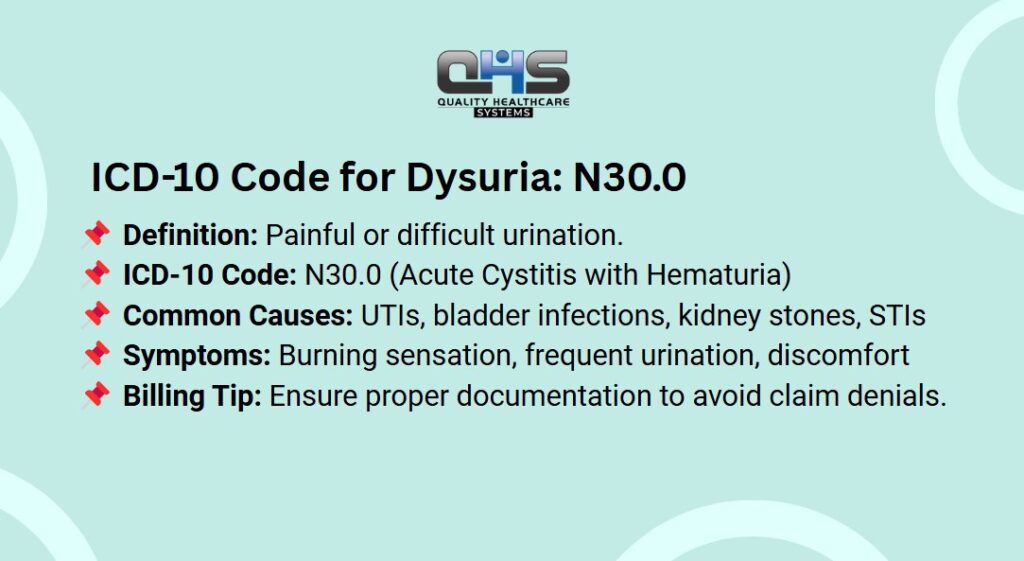Dysuria refers to painful or uncomfortable urination, often described as a sharp, burning sensation. In some cases, individuals experience pain over the perineum or bladder. This condition can stem from infections, inflammation, or other underlying medical issues. Dysuria ICD-10 code is used in medical documentation to diagnose and track cases of painful urination, ensuring accurate medical records and treatment plans.
What is the ICD-10 Code for Dysuria?
The ICD-10 code for dysuria is R30.0. This is a billable code under the International Classification of Diseases (ICD-10) and is used in healthcare billing, insurance claims, and patient records. According to the Centers for Medicare & Medicaid Services (CMS), this code is applicable for conditions involving painful urination, with specific guidelines for accurate reimbursement.
Who is at Risk for Dysuria? – ICD-10 Code for Dysuria
Dysuria (painful urination) can affect anyone, but it is more common in women, pregnant individuals, and those with diabetes or bladder conditions. Urinary tract infections (UTIs) are a leading cause, especially in women.
For medical records and insurance purposes, dysuria is classified under the ICD-10 code R30.0, which helps healthcare providers document and bill for appropriate care.
ICD-10 Codes for Dysuria and Urinary Disorders
| ICD-10 Chapter | Code | Condition | Clinical Relevance |
| Diseases of the Genitourinary System (Chapter 14) | N39.8 | Other specified disorders of the urinary system | Covers urinary conditions that don’t fit specific ICD-10 categories |
| Symptoms, Signs, and Abnormal Clinical Findings (Chapter 18) | R30.0 | Dysuria (Painful Urination) | Indicates discomfort or burning sensation while urinating, commonly linked to UTIs, STIs, or bladder issues |
What are the Causes of Dysuria?
Dysuria can result from various underlying conditions, making it crucial to identify the root cause for effective treatment. Understanding these causes helps in accurate diagnosis and appropriate medical intervention, ensuring better patient outcomes.
- Urinary tract infection (UTI) ICD-10 code: N39.0 – UTIs are the most common cause of painful urination.
- Prostatitis (ICD-10: N41.0) – Inflammation of the prostate gland, leading to discomfort.
- Urethritis (ICD-10: N34.1) – Inflammation of the urethra, often due to bacterial infections.
- Bladder infection ICD-10 code: N30.0 – Cystitis and bladder irritation can trigger dysuria.
- Kidney stones (ICD-10: N20.0) – Stones in the urinary tract may cause sharp pain while urinating.
- Sexually transmitted infections (STIs), such as chlamydia (ICD-10: A74.9) and gonorrhea (ICD-10: A54.9) – Common causes of dysuria in both men and women.
- Use of irritating products – Certain soaps, spermicides, and personal care products may contribute to dysuria.
What are the Symptoms of Dysuria?
The primary symptom of dysuria is a burning, stinging, or itching sensation during urination. According to the Drugs.com, symptoms of painful urination ICD-10 include:
- Pain at the start of urination may indicate a urinary tract infection (UTI).
- Pain after urination could signal bladder or prostate issues.
- Men may experience discomfort in the penis before or after urination.
- Women may have internal pain (linked to UTIs) or external irritation from inflammation.
Accurate symptom documentation using ICD-10 code R30.0 ensures clarity in medical records and supports appropriate treatment plans.
How is Dysuria Diagnosed?
To confirm Dysuria ICD-10 code R30.0, healthcare providers follow standard diagnostic protocols, as recommended by the American Urological Association (AUA) and the Centers for Disease Control and Prevention (CDC):
- Urinalysis – Detects infections, blood, or abnormalities in the urine.
- Urine culture – Identifies bacterial infections that may be causing dysuria.
- Cystoscopy – Uses a thin, flexible tube with a camera to examine the bladder and urethra for structural issues.
- Imaging tests (CT scans, ultrasounds) – Recommended in cases where kidney stones, tumors, or anatomical abnormalities are suspected.
A proper diagnosis, recorded under ICD-10 code R30.0, helps guide treatment decisions and ensures that patients receive the right care.
What are the Treatment Options for Dysuria?
According to the Cleveland Clinic, treatment for ICD-10 urinary disorders depends on the underlying cause:
- Antibiotics – Used for bacterial infections (e.g., UTIs, prostatitis, STIs).
- Pain relievers – Phenazopyridine is commonly prescribed for pain relief but should only be used for short durations.
- Increased hydration – Helps flush out irritants and bacteria.
- Avoidance of irritants – Limiting the use of scented hygiene products and certain medications that may cause irritation.
Treatment Options Based on the Underlying Cause
| Condition | Treatment | Medication Example |
|---|---|---|
| UTI (N39.0) | Antibiotics | Nitrofurantoin, Trimethoprim-Sulfamethoxazole |
| Prostatitis (N41.0) | Antibiotics, anti-inflammatories | Ciprofloxacin, Ibuprofen |
| Kidney Stones (N20.0) | Hydration, pain management, surgery if needed | Tamsulosin, Lithotripsy (shock wave treatment) |
| Urethritis (N34.1) | Antibiotics | Azithromycin, Doxycycline |
| Bladder Infection (N30.0) | Antibiotics, increased water intake | Fosfomycin, Cephalexin |
How Does the ICD-10 Code for Dysuria Impact Medical Billing?

The ICD-10 code R30.0 for dysuria plays a crucial role in medical billing by ensuring accurate claim submissions and reimbursement. As stated by the Centers for Medicare & Medicaid Services (CMS), proper coding prevents claim denials and supports compliance with healthcare regulations.
- R30.0 code reimbursement is essential for accurate medical billing and claims processing.
- Incorrect coding can lead to claim denials or delays in payment.
- ICD-10 compliance for dysuria ensures proper documentation for healthcare providers and insurance companies.
What are Other Related ICD-10 Codes for Urinary Conditions?
Apart from Dysuria ICD-10 R30.0, the following codes may also be relevant:
| Condition | ICD-10 Code | Description |
|---|---|---|
| Urinary Tract Infection (UTI) | N39.0 | Infection of the urinary system, commonly causing dysuria |
| Prostatitis | N41.0 | Inflammation of the prostate, often leading to painful urination |
| Urethritis | N34.1 | Inflammation of the urethra, typically due to infections |
| Bladder Infection (Cystitis) | N30.0 | Inflammation of the bladder causing discomfort and frequent urination |
| Kidney Stones | N20.0 | Hard deposits in the kidneys or urinary tract, causing sharp pain and difficulty urinating |
| Hematuria (Blood in Urine) | R31.9 | Presence of blood in the urine, often linked to infections or kidney issues
|
ICD-10 Coding Guidelines for Dysuria (R30.0)
- Ensure all related symptoms and causes are documented correctly.
- Follow official coding guidelines from CMS and World Health Organization (WHO) for proper classification.
- Reference government and authorized medical sources to validate billing claims.
By using the correct billing code for dysuria, healthcare providers can ensure proper treatment documentation and smooth reimbursement processes.
ICD-10 Code Set: A Global Standard by the World Health Organization
The ICD-10 (International Classification of Diseases, 10th Edition) is a standardized coding system developed by the World Health Organization (WHO) to classify diseases, symptoms, injuries, and medical conditions. This system is essential for accurate clinical documentation, medical billing, and global health data analysis.
Why Is ICD-10 Important?
ICD-10 plays a vital role in healthcare by:
- Ensuring Accurate Medical Billing – Under the Health Insurance Portability and Accountability Act (HIPAA), healthcare providers must use ICD-10 codes when submitting insurance claims. These codes replace the older ICD-9 system and provide greater precision in diagnoses and treatment classification.
- Improving Patient Care & Treatment Tracking – Each code represents critical details about a medical condition, allowing healthcare providers to track disease patterns, treatment effectiveness, and patient outcomes.
- Facilitating Global Healthcare Data Standardization – ICD-10 enables healthcare professionals worldwide to share and compare medical data, improving research, epidemiology, and public health initiatives.
How Does ICD-10 Impact Healthcare Providers?
For physicians, hospitals, and medical coders, ICD-10 simplifies documentation and ensures compliance with insurance and regulatory requirements. It also helps reduce coding errors, minimizes claim rejections, and streamlines medical record-keeping.
By using ICD-10, healthcare providers improve accuracy in diagnoses and billing, leading to better patient care and a more efficient healthcare system.
For more details on ICD-10, visit the World Health Organization’s official page.
Frequently Asked Questions
What is the correct ICD-10 code for dysuria?
The correct ICD-10 code for dysuria is R30.0. This code is used to document cases of painful or difficult urination in medical records, insurance claims, and healthcare billing.
Can the ICD-10 code R30.0 be used for all cases of painful urination?
No, R30.0 is specifically for dysuria but should not be used if a more specific diagnosis applies. For example, if dysuria is due to a urinary tract infection (N39.0) or prostatitis (N41.0), those codes should be used instead.
How does the ICD-10 code for dysuria impact medical billing?
The ICD-10 code R30.0 ensures proper claim submission and reimbursement by categorizing painful urination as a recognized medical condition. Accurate coding prevents claim denials and helps healthcare providers receive appropriate payment.
Are there additional ICD-10 codes related to dysuria?
Yes, several ICD-10 codes are associated with conditions that cause dysuria, including:
- N39.0 – Urinary tract infection
- N30.0 – Bladder infection (Cystitis)
- N34.1 – Urethritis
- N41.0 – Prostatitis






